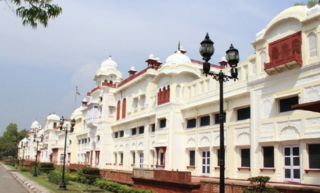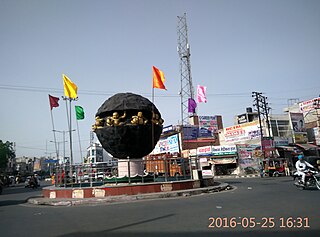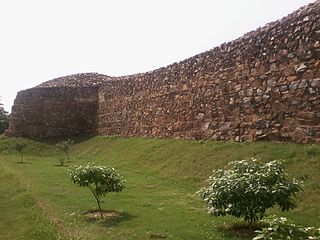
Patiala is a city in southeastern Punjab, northwestern India. It is the fourth largest city in the state and is the administrative capital of Patiala district. Patiala is located around the Qila Mubarak constructed by the Sidhu Jat Sikh chieftain Ala Singh, who founded the royal dynasty of Patiala State in 1763, and after whom the city is named.

The Lahore Fort is a citadel in the city of Lahore in Punjab, Pakistan. The fortress is located at the northern end of Walled city of Lahore and spreads over an area greater than 20 hectares. It contains 21 notable monuments, some of which date to the era of Emperor Akbar. The Lahore Fort is notable for having been almost entirely rebuilt in the 17th century, when the Mughal Empire was at the height of its splendor and opulence.

The Walled City of Lahore, also known as the Old City, forms the historic core of the city of Lahore in Punjab, Pakistan. The city was established around 1000 CE in the western half of the Walled City, which was fortified by a mud wall during the medieval era. It is the cultural centre of the Punjab region.

Bathinda is a city and municipal corporation in Punjab, India. The city is the administrative headquarters of Bathinda district. It is located in northwestern India in the Malwa Region, 227 km (141 mi) west of the capital city of Chandigarh and is the fifth largest city of Punjab. It is the second cleanest city in Punjab after Mohali.

Faridkot is a city in the South-western part of state of Punjab, India. It serves as the headquarters for both, the Faridkot district. as well as the Faridkot Division. The division was established in 1995 at Faridkot which includes Faridkot, Bathinda, and Mansa districts.

The Red Fort or Lal Qila is a historic fort in the Old Delhi neighbourhood of Delhi, India, that historically served as the main residence of the Mughal emperors. Emperor Shah Jahan commissioned construction of the Red Fort on 12 May 1639, when he decided to shift his capital from Agra to Delhi. Originally red and white, its design is credited to architect Ustad Ahmad Lahori, who also constructed the Taj Mahal. The fort represents the peak in the Mughal architecture under Shah Jahan and combines Persian palace architecture with Indian traditions.

Purana Qila is one of the oldest forts in Delhi, India. It was built by the second Mughal Emperor Humayun and Surid Sultan Sher Shah Suri. The fort forms the inner citadel of the city of Dinpanah. It is located near the expansive Pragati Maidan exhibition ground and is separated from the Dhyanchand Stadium by the Mathura Road, Delhi.

Kaithal is a city and municipal council in the Kaithal district of the Indian state of Haryana. Kaithal was previously a part of Karnal district and later, Kurukshetra district until 1 November 1989, when it became the headquarters of the Kaithal. It shares a border with the Patiala district of state Punjab and the Kurukshetra, Jind and Karnal districts of Haryana. Kaithal district is situated in the North-West of the Haryana state. Its North-West boundaries, which include Guhla-Cheeka are attached to Punjab.

Lal Kot or Qila Rai Pithora is a fortified complex in present-day Delhi, which includes the Qutb Minar complex. It was constructed in the reign of Tomara king Anangpal Tomar between c. 1052 - c.1060 CE. It is termed as the "First city of Delhi". Remains of the fort walls are scattered across South Delhi, visible in present Saket, Mehrauli around Qutb complex, Sanjay Van, Kishangarh and Vasant Kunj areas.

Kesgarh Qila or Takht Kesgarh Sahib, alternatively spelt as Keshgarh Qila, is one of the five takhts of the Sikhs located in Anandpur Sahib in Rupnagar district of Punjab, India. It is located just 40 km from Rupnagar city, the district headquarters and 78 km from state capital Chandigarh. The fort is also called Takhat Keshgarh Sahib. This Gurdwara was one of the forts constructed by Guru Gobind Singh at Anandpur Sahib for the defense of the Sikhs. He spent his 25 years at Anandpur Sahib and, to protect the Sikhs from the Rajas of the Hill States and Mughals, began the construction of five defensive Qilas (forts) all around the town.

Delhi has been an important political centre of India as the capital of several empires. The recorded history of Delhi begins with the 8th century Tomar Rajputs kingdom. It is considered to be a city built, destroyed and rebuilt several times, as outsiders who successfully invaded the Indian subcontinent would ransack the existing capital city in Delhi, and those who came to conquer and stay would be so impressed by the city's strategic location as to make it their capital and rebuild it in their own way.

The Maharaja of Patiala was the title of a Maharaja in India and the ruler of the princely state of Patiala, a state in British India. The first Maharaja of Patiala was Baba Ala Singh (1695–1765).

Jamal ud-Din Yaqut was an African Siddi slave-turned-nobleman who was a close confidant of Razia Sultana, the first and only female monarch of the Delhi Sultanate in India. Yakut was the puppet of Razia Sultan's stepmother but after sometime he became a trustworthy soldier of the Delhi Sultanate. Razia Sultana's patronage made him an influential member of the court, provoking racial antagonism amongst the nobles and clergy, who were both primarily Turkic and already resentful of the rule of a female monarchy.
Malik Ikhtiyar-ud-din Altunia was the governor of Bathinda in (Punjab) under the rule of the Delhi Sultanate under the Mamluk dynasty. He was the husband of Razia Sultana.

Sirhind is the older name of Fatehgarh Sahib, a city and Sikh pilgrimage site in Punjab, India. It is situated on the Delhi to Lahore Highway. It has a population of about 60,851 . It is now a district headquarters in the state of Punjab; the name of the district is Fatehgarh Sahib.

Qila Mubarak is a fortress of Sikh architecture in Patiala, Punjab, India.

The Sikh Rule in Lahore initiated from the conquest and rule of the Sikh Misls and extended till the Sikh Empire of Ranjit Singh which ended in 1849. The Sikhs began gaining power following the decline of the Mughal Empire in Punjab and consisted of a collection of autonomous Punjabi Misls, which were governed by Misldars, mainly in the Punjab region.

Anangpal II, popularly known as Anangpal Tomar, was an Indian ruler from the Tomara dynasty. He is known to have established and populated Delhi in the 11th century. He is often confused with Anangpal I, the founder of Tomar Dynasty of Delhi, who had reigned during the 8th century. He traced the lineage to Chandravanshi Kshatriya kings, namely Arjuna from the epic Mahabharata.
The Warya is a Rajput clan found predominantly in the Punjab and Sindh provinces of Pakistan and in the state of Gujarat in India.

The Delhi–Fazilka line is a railway line connecting Delhi and Fazilka the latter in the Indian state of Punjab. There is a link to Firozpur Cantonment. The line is under the administrative jurisdiction of Northern Railway. This line was a part of the historic Delhi–Karachi line.

























